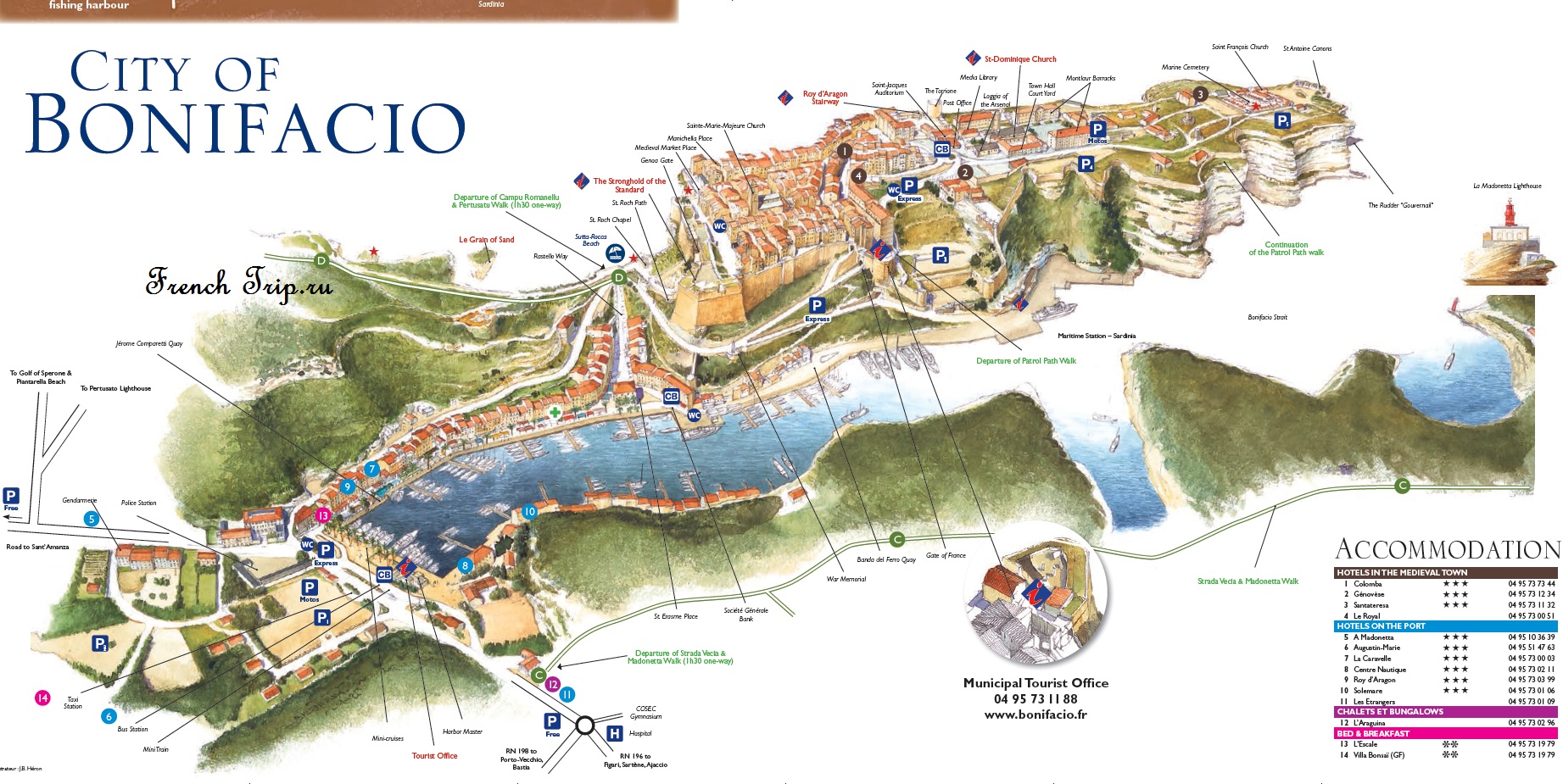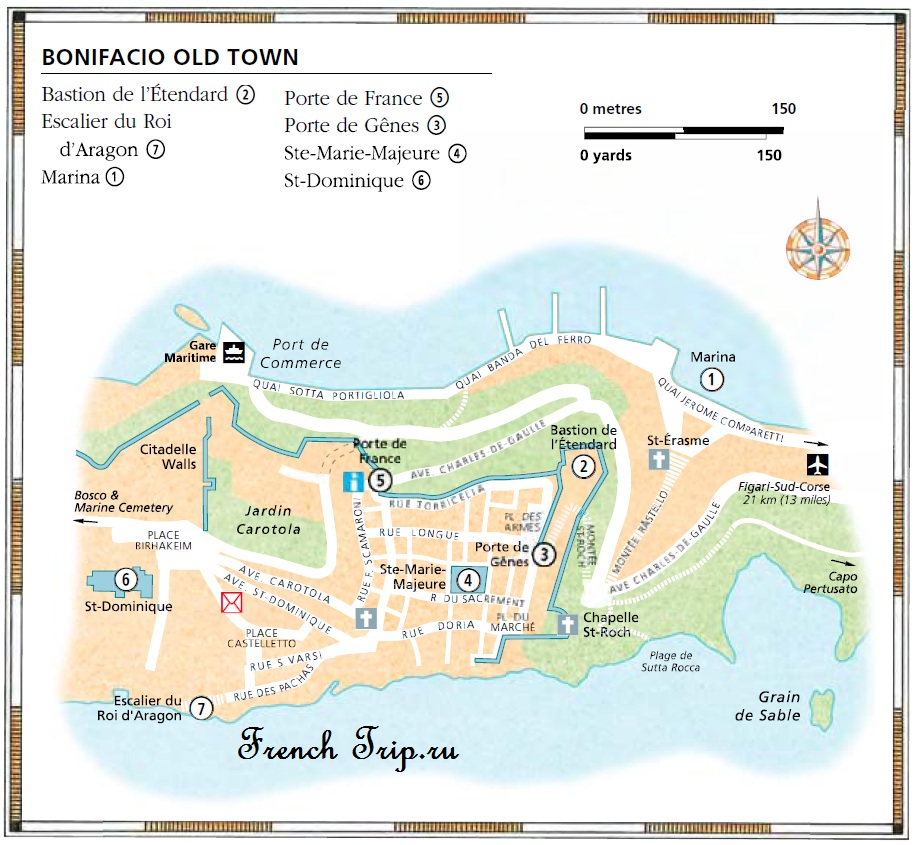Bonifacio Main Sights
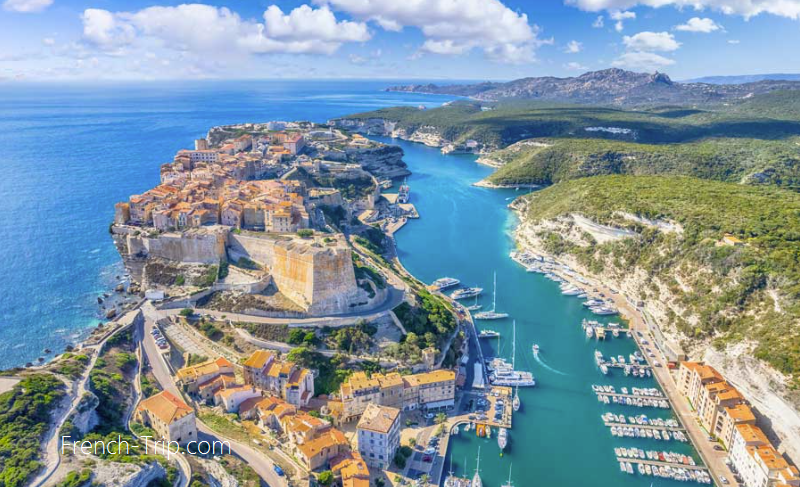
Visiting Bonifacio, City of Art and History since 2019, means discovering one of the emblematic cities of Corsica. With its houses perched on the edge of white limestone cliffs, this medieval city is famous all over the world! The city, shrouded in the myths of Odysseus, washed by stormy waves, with its own character, will leave an indelible impression on you. Even after years of traveling around France, I remember Bonifacio with great tenderness and am ready to return there at any time! Bonifacio main sights include not only a traditional old town behind the fortified wall. It is incredible nature, a rugged picturesque coastline, with steep cliffs and a turquoise sea! Be sure to take a cruise excursion to admire all this from the sea, feeling like… Odysseus?
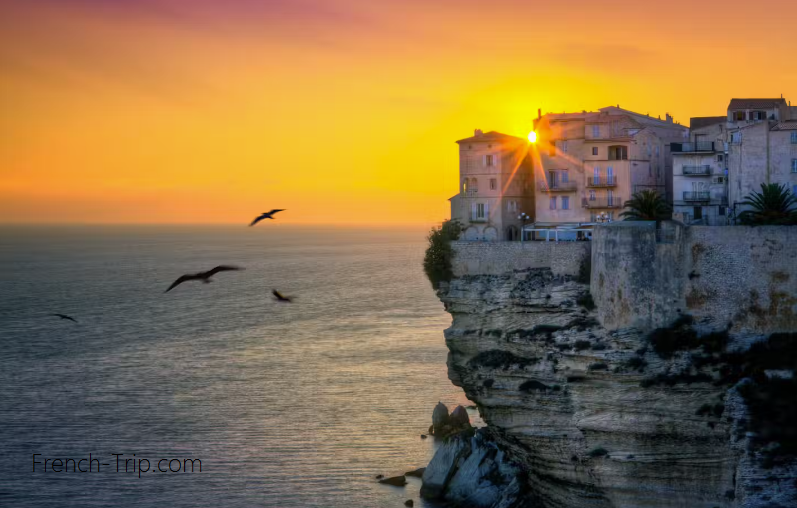
Bonifacio attractions on the city map:
Bonifacio Main Sights
Bonifacio Old Town
Perched on a cliff, the old town offers panoramic views of the sea, but also reveals the history of Bonifacio, including the Genoese period. Enjoy a stroll through the narrow old streets and alleys, have a leisurely dinner outside in one of the many restaurants, tasting excellent Corsican wine and traditional dishes.

Town Houses
Some of the townspeople’s houses have survived from the medieval town and still attract attention with their original decorative architectural elements, all carved mainly from limestone and sometimes from slate.
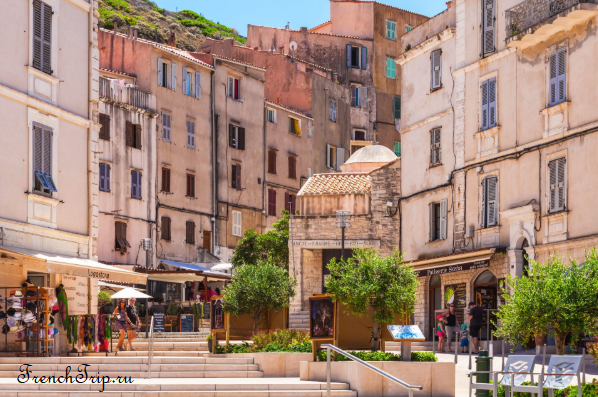
Citadel of Bonifacio
In 1195, the Genoese recaptured Bonifacio from Pisa and began to strengthen the existing fortress. In the 14th century, a complete modernization of the fortifications was completed. The fortress was again strengthened by the French in the 16th century after the Franco-Turkish siege. As a result, the fortress has retained most of those fortifications to this day and is the main attraction of Bonifacio. Within its walls, the old town has been preserved with many interesting places and churches.
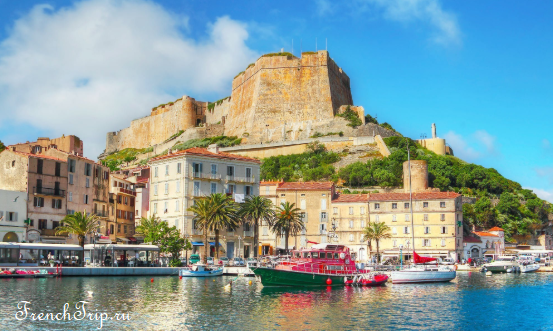
You can enter the citadel through the Genoese Gate:
Genoese Gate
Porte de Gênes or Gate of Genoa. For centuries, it served as the only entrance to the upper town until a new gate, the Porte de France, was built in the 19th century. The impressive drawbridge is an 1830 replacement for the 17th-century original. The bastion that guards the gate has now been converted into a museum. Unfortunately, you cannot walk along the picturesque stepped path at the top of the walls (Chemin de Ronde or Patrol Path) as it is closed for security reasons.
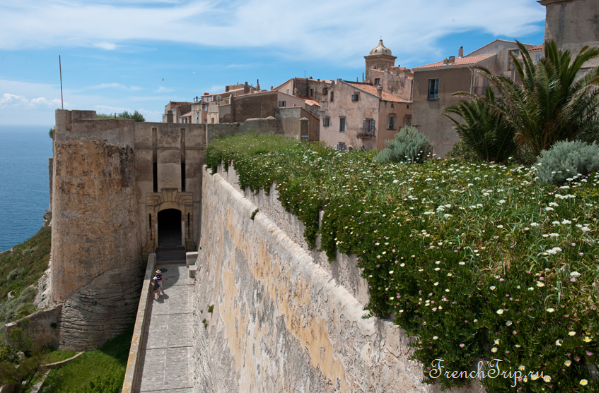
Bastion de l’Etendard and Museum
The bastion was built in the 13th century by the Genoese to protect the city from sea and land (until the mid-19th century, the Genoese Gate remained the only entrance to the city). Until the 19th century, access to the bastion was only through eight successive gates and a drawbridge.
The Bastion de l’Etendard (Bastion Memorial) is the main museum of the Citadel of Bonifacio, chronicling the turbulent life and times of the city.
The Fortress of the Standards, built in the 15th century and dominating the port from a height of 25 meters, is the highest fortress in France. This imposing is the main component of the fortifications!
The underground halls
The exhibition “1000 years of fortifications”. Partially dug into the rock, the underground halls are definitely worth a visit! The round vaults of the great hall remind us of the medieval architecture of the ancient defensive tower… The museography, indicated by signs and video projections, goes back to the history of the city’s fortifications. An exhibition rich in visual documentation, sometimes unpublished, but accessible to everyone!
For children
Ask for the discovery game; follow Fanfan, the flying donkey! For children aged 7-12 (must be able to read), don’t forget to ask for the free illustrated game booklet at the entrance! The youngest children can also play with medieval helmets.
Visit museum:
- Visit time: 30 minutes
- Opening hours: April to October.
- Tickets: € 3; together with the Escalier du Roi d’Aragon (Staircase of Aragon) — Monument Pass: € 6.50. Children 6-11 — € 2.00
- Website
Place d’Armes
After going up through the Genoese Gate, you will find yourself on the “Place of Arms” (the gate is on the left, the bastion is on the right). From here, the Rue de Deux Empereurs (Street of Two Emperors) goes deep into the city. It got its name for a reason: in 1541, Emperor Charles V stayed in the house on the left of the street for three days during his visit from North Africa, and Napoleon Bonaparte lived in the house on the right for two and a half months in 1793.
Place du Marché
Place du Marché — is a market square that you will reach if you go from the Genoese Gate all the way to the left along the wall. From the square, a promenade leads to the King of Aragon’s Staircase and further on to the donjon. From here, there are beautiful views of the sea and Sardinia.
Aragon Staircase
From the southwest edge of the citadel, 187 steps of Escalier du Roy d’Aragon lead down the sheer cliff face (their diagonal cut is very visible from the sea) to the Cave of the Well of Saint Barthélemy. This cave, which cannot be entered at present, contains a pool of fresh (or relatively fresh) water that seeped down from the limestone above, so it was an important source of water for the city. The well was drilled directly from the Church of Saint Bartholomew on the headland.
The steps are named after Alfonso V, King of Aragon, who gained control of Bonifacio in 1421 from the Genoese, but the city resisted him. A fanciful legend has it that his men fought on the steps and were repelled, but more likely he was simply trying to cut off the water supply to force the city to surrender. However, he failed and left.
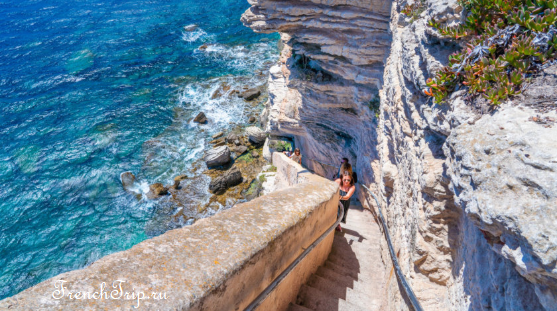
There is talk of restoring these and other ancient cisterns as an environmentally friendly way to increase the city’s water supply, which has always been unreliable.
Visit stairs:
- Opening hours: May–September 09:00–20:00; April 09:00–19:00; October 10:00–17:00.
- Tickets: €2.50; combined with Bastion de l’Etendard €6.50.
- Every child over 3 years old who climbs these picturesque steps will receive a diploma.
- Requires a good level of physical fitness as well as several safety rules.
- Access to the stairs is only permitted for people wearing flat and closed-toe shoes (flip-flops, sandals and heels are not allowed).
- A baby carrier is required for children under 3 years old.
- Helmets are provided during the tour.
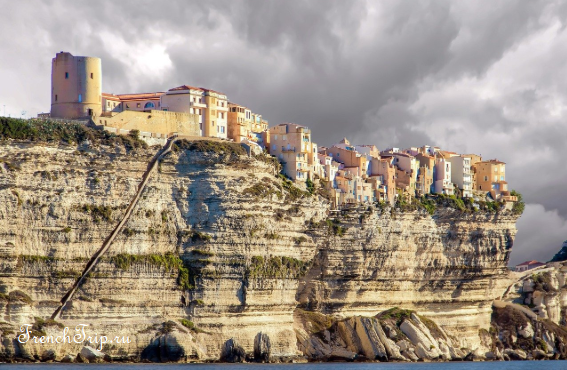
The citadel is only about 200 metres long, so in a few minutes you will pass the Porte de France car entrance, the town hall, the monument to the French Foreign Legion and the western gate that opens onto a limestone strip. Here you will find the Church of Saint Dominic, a Tuscan watchtower and the loggia of the Arsenal.
To the west stretches the cape or Plateau Bosco, once covered with forests (‘bosco’) of olive trees but now bare and windless. The Rue des Moulins leads past abandoned military buildings and the stumps of ancient windmills to the sea cemetery and, importantly, to the citadel’s main car park.
Church of Saint Dominic
Classified as a historical monument by Prosper Mérimée in 1862, the Church of Saint Dominic is a rare example of Gothic architecture in Corsica. The building is sober in style and is decorated with paintings representing iconography valuable to the Dominican Order, as well as important sculptures.
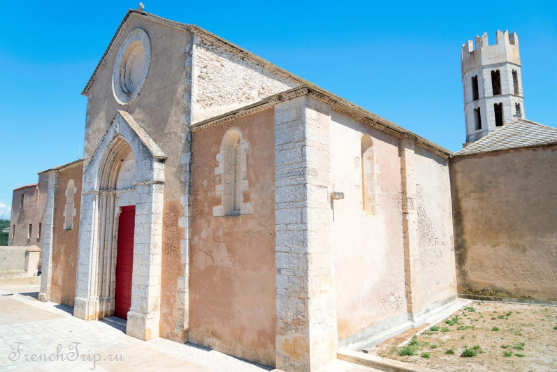
The church contains wooden Baroque sculptures – relics of St. Mary Magdalene and St. Bartholomew. The church is also interesting for its numerous stone tombstones of local residents who were buried here before the opening of the Marine Cemetery in 1823.
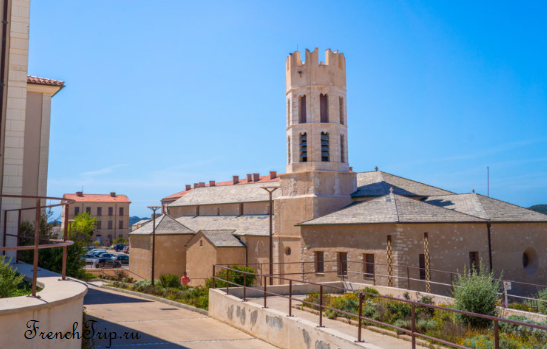
Loggia de l’Arsenal
The church of Saint Dominic was part of a Dominican monastery, of which all that remains is the church (mentioned above) and this loggia, the former refectory. On Fridays, the colonnaded square hosts a farmers’ market.
The loggia, located opposite the entrance to the church of Sainte-Marie-Majeure, was in medieval times the central place in the city where people met, judgements were made and public announcements were made. Various notarial transactions (purchase/sale) were also carried out here.
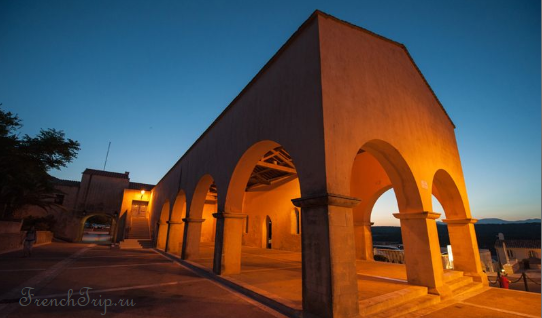
Church of Sainte Marie Major
Église Sainte-Marie-Majeure (Church of Sainte Marie Major) is the main and oldest church in the city, mainly Romanesque and probably built in the 12th century, but much altered over time. It is first mentioned in 1238 and is thought to have been built in the 12th century when Corsica was ruled by Pisa, but was later rebuilt by the Genoese, as it does not look much like a standard Pisan church, but the Romanesque style is strong.
The church has a prominent bell tower and three naves. The central nave contains the relics of Saint Boniface. At the front, note the loggia, a covered passage for medieval dignitaries to gather to discuss city affairs. Below it is a large water cistern, fed from the surrounding buildings by the buttresses of an aqueduct spanning the streets. In 1980, they tried to turn the cistern into a conference center, but oddly enough, it filled with water every time it rained.
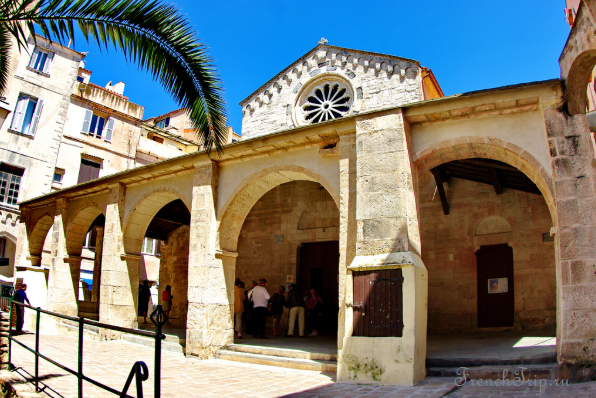
This beautiful and large church (over 500 m2) contains many classified art objects (some have migrated to the Museum of Sacred Arts), among which are the magnificent altar and side altars in polychrome marble from the 17th century, the Statue of St. Francis in Brando marble, the “black” Christ on the cross of the altar of the Souls in Purgatory, a large tabernacle in white marble from the 17th century, numerous funerary slabs, etc.
The church’s bell tower (“u Campanin“) is 25 meters high. Its shape is unique on the island. It has four floors, the first in Romanesque style and the other Gothic (the tower is classified as a historical monument).
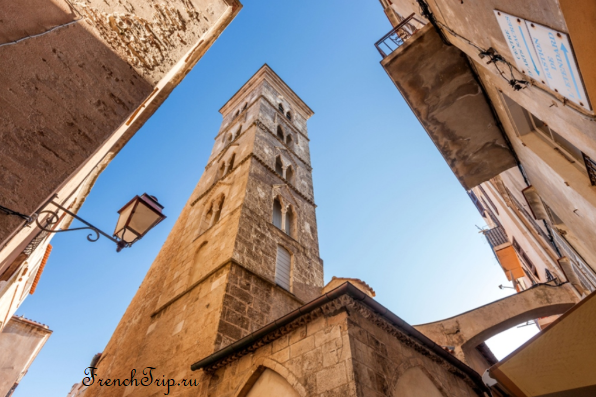
Chapel of Saint-Roch
Chapelle de Saint-Roch. This tiny chapel marks the spot where the last victim of the plague died during the 1528 outbreak. St. Roch/Roc, a 14th-century martyr from Montpellier, is particularly venerated for his intercessions against the plague, and on behalf of bachelors, falsely accused people, and dogs. His Saint’s Day is celebrated here annually on August 16.
Other Churches in Bonifacio
In addition to the Church of Sainte-Marie-Majeure, you can see other churches during your stay in Bonifacio:
- Church of Saint-Jean Baptiste (église Saint-Jean Baptiste): (corner of Rue Doria and Rue Saint-Jean-Baptiste) was built in 1785 and is nicknamed the “Chapel of Mercy”. Inside, it is worth seeing the wooden sculpture depicting the beheading of John the Baptist.
- Church of Saint-Dominique (église Saint-Dominique): listed as a historical monument, it is one of the few in Corsica that has some elements of Gothic architecture. The church was completed in 1343. It is located outside the city walls, towards the Marine Cemetery. It is the largest church in Bonifacio. The decoration of the church is very modest, which is not typical for Gothic churches. Thanks to the very good acoustics of the church, concerts are often held here.
- Church of Saint Erasme (église Saint-Erasme): dedicated to the patron saint who protects fishermen, it is the only one in the lower part of the city, towards the port.
- Church of Sainte-Croix (église Sainte-Croix): an old hospice founded in the 12th century and containing a fragment of the cross of Christ.
- Church of Saint James (Église Saint-Jacques de Bonifacio). A former church built by the Genoese at the beginning of the 14th century and run by the Benedictine order. After the French Revolution it was closed, then used as a warehouse, recently converted into a concert hall. From the outside it is not very presentable, but its former purpose is clear.
Il Torrione
Il Torrione (Tuscan watchtower, donjon in the west wall), Rue des Pachas. The watchtower is the only structure in the citadel that remains from the original 9th-century Tuscan fortifications. The tower has been destroyed and rebuilt several times: the most recent destruction was in 1901 (because it gave enemy artillery too good a marker for the city), and what you see now is a 1980 reconstruction.
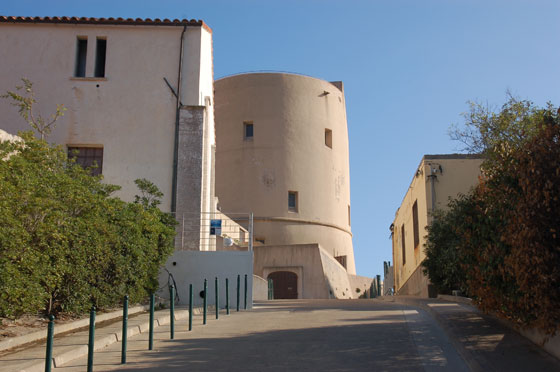
Marine Cemetery
For over 300 years, this cemetery, named after Saint Francis (Cimetière marin de san Franzé), has dominated the town, perched on the edge of a cliff overlooking the sea. Right next to the cemetery is the church and monastery of San François, an example of pure and simple Gothic architecture.
Overlooking the Bouches de Bonifacio, you can stroll between the white tombs that contrast with the blue sea in the background. Interestingly, these are not simple grey tombs, but rather small family temples and chapels.
The Bonifacio Marine Cemetery is one of the most beautiful in the Mediterranean. The richest families of the town are buried here. Outside, the cemetery runs along the entire cape along the so-called Promenade of Saint Francis, offering wonderful views.
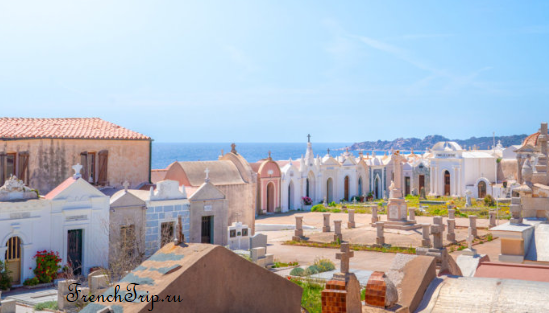
Covered Path – Le Gouvernail
As you leave the Marine Cemetery, just opposite, you will find the entrance to this tunnel.
This covered descent is part of the fortifications of Bonifacio, which were first restored in the 16th century. Walk along the path, feel the strengths and weaknesses of the natural fortifications.
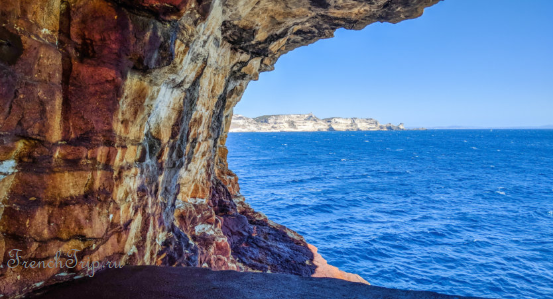
Built in 1890 by the French, this tunnel was later used by the Italian and German armies during World War II. During your visit, you will walk up a 168-step staircase dug by the men to reach the blockhouse. There was also a huge searchlight with a range of 12 km used to monitor the entrance to the harbour and part of the Strait of Bonifacio. Situated about 10 metres above sea level, the blockhouse overlooks a rock whose shape, reminiscent of a ship’s rudder, gave the place its name. The view of the rocks and the entrance to Goulet is really good.
Entrance to the tunnel costs 2.50 euros per person. It is not included in the Pass monument.
Palazzu Publicu
This palace of the Genoese governor is located on Rue du Palais. It was built in the Middle Ages.
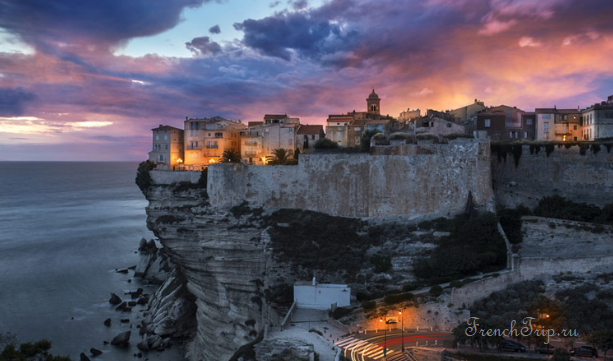
You can also admire the sights of Bonifacio from the sea if you take one of the cruises that leave from the port of Bonifacio every 20 minutes (short cruise) or every hour (cruise to the Lavezzi Archipelago). Read more…

Bonifacio Main Sights on the Map:
→ Back to Bonifacio travel guide
Archives
Calendar
| M | T | W | T | F | S | S |
|---|---|---|---|---|---|---|
| 1 | 2 | 3 | 4 | 5 | 6 | 7 |
| 8 | 9 | 10 | 11 | 12 | 13 | 14 |
| 15 | 16 | 17 | 18 | 19 | 20 | 21 |
| 22 | 23 | 24 | 25 | 26 | 27 | 28 |
| 29 | 30 | 31 | ||||
